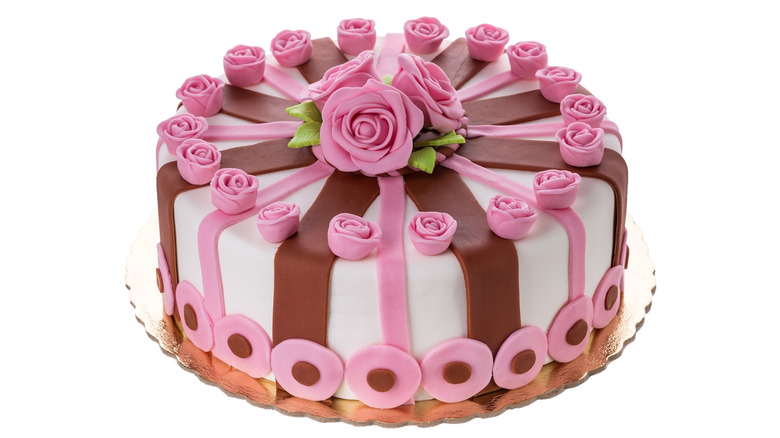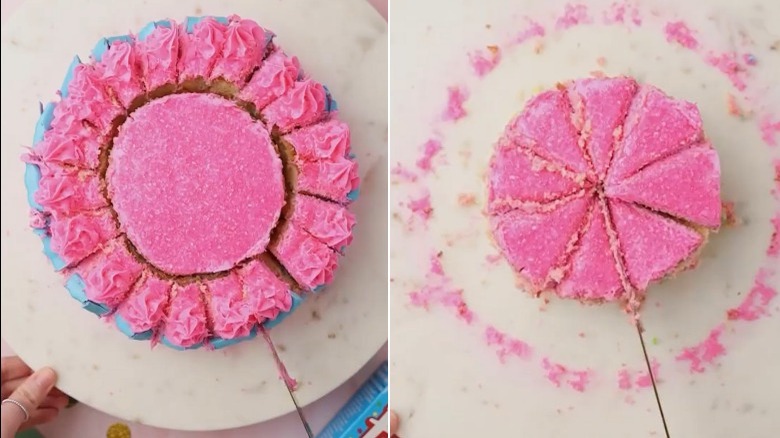The Trick To Easily Cutting A Round Cake Into Perfect Servings
Large gatherings and socializing have become more important to Americans since COVID-19 began, according to Pew Research Center. And that's brought up all the usual questions such as what to wear, what to serve, or what to bring if you're a guest. And, of course, it seems we're back to that age-old quandary: How to divide a standard-sized round cake into enough portions to serve every guest — and how to do so without turning your beautiful baked good into a pile of crumbs.
Round cake pans, which are standard for layer cakes, come in many sizes, but the most common ones are 8 or 9 inches in diameter, according to Craftsy. An 8-inch pan should yield 20 servings, and a 9-inch pan should yield 24. Now, what if we told you that you might be able to coax even more servings out of a single cake, and you could do so while maintaining the integrity of your slices? Well, it just so happens that's what we're about to do. Follow along as we reveal the trick to easily cutting a round cake into many perfect servings.
The rings of power
For advice on cake slicing, we turned first to baking supply company Wilton because it's been doing this sort of thing for 90+ years (per Wilton). Wilton suggests cutting a 6-inch diameter circle into the center of your 8-inch cake, then slicing the resulting ring-shaped perimeter at about inch-and-a-half intervals, and finally, slicing up the 6-inch cake that remains into the standard wedges most often associated with slices of layer cake. The yield? Anywhere from 30 to 33 servings! For larger cakes, the same rules apply. For cakes with diameters of 6 inches or less, you'll do fine just by cutting the cake 6-8 equal-sized standard wedges.
You can get a sense of how this easy-cutting method works from the photo above. It comes from Pillsbury's Funfetti brand (via Instagram), which we'll admit, we consulted when it occurred to us that as easy as Wilton makes it sound, we still imagined struggling a bit when it came to slicing cakes slathered in fluffier frostings and fillings. But as you can see, the method works on the fluffy frosted cake on which Funfetti does its cake-slicing demonstration. That being said, Funfetti recommends slicing the perimeter ring into 1-inch slices. That could make it easier or harder, depending on your cake-cutting skills and talents.
We've got a few other tips from the cake-slicing experts as well.
Pro-tips for the perfect sliced cake
For denser, stickier cakes (like our flourless chocolate torte) and cakes with fillings/frostings, Wilton recommends rinsing the knife between slices. For spongey cakes (like our orange chiffon), a bread knife is your friend. An alternative offered by Tastemade is winding a generous length of unflavored dental floss tightly between your hands; keeping it level, lower it into the cake for a precision slice. YouTube channel Byu dining demonstrates this technique in the photo above, saying you can also use fishing line. In all cases, placing the cake on a grippy surface before cutting should also help.
Now, in the interest of full disclosure, it's worth noting that the slices from the outer ring(s) will not be equal in size to the slices from the center, as one Instagram user noted in a comment to Funfetti's aforementioned Instagram post. Another commenter pointed out that slices from the perimeter may have more frosting than interior slices, noting "cake is literally just a socially acceptable vessel for the frosting for me." Of course, some will be happy to see less frosting, so a host might use that to advantage by serving the interior versus exterior slices on separate serving dishes, and letting the guests decide.
So give these tips a try, and if you somehow end up with leftovers, here's a method for freezing cake slices to preserve freshness.


